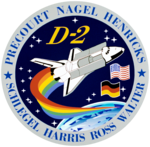STS-55
| Mission emblem | |||
|---|---|---|---|

|
|||
| Mission dates | |||
| Mission: | STS-55 | ||
| COSPAR-ID : | 1993-027A | ||
| Crew: | 7th | ||
| Begin: | April 26, 1993, 14:50:00 UTC | ||
| Starting place: | Kennedy Space Center , LC-39A | ||
| Landing: | May 6, 1993, 14:29:59 UTC | ||
| Landing place: | Edwards Air Force Base , Runway 22 | ||
| Flight duration: | 9d 23h 39m 59s | ||
| Earth orbits: | 160 | ||
| Rotation time : | 90.5 min | ||
| Orbit inclination : | 28.4 ° | ||
| Apogee : | 306 km | ||
| Perigee : | 298 km | ||
| Covered track: | 6.7 million km | ||
| Payload: | Spacelab | ||
| Team photo | |||
 v. l. No. Front: Terence Henricks, Steven Nagel, Charles Precourt; Back: Bernard Harris, Hans Wilhelm Schlegel, Jerry Ross, Ulrich Hans Walter |
|||
| ◄ Before / After ► | |||
|
|||
STS-55 ( english S pace T ransportation S ystem) is a mission designation for the US Space Shuttle Columbia (OV-102) NASA . The launch took place on April 26, 1993. It was the 55th space shuttle mission and the 14th flight of the Columbia space shuttle.
team
Main team
- Steven Nagel (4th space flight), commander
- Terence Henricks (2nd space flight), pilot
- Jerry Ross (4th Spaceflight), Mission Specialist
- Charles Precourt (1st spaceflight), mission specialist
- Bernard Harris (1st spaceflight), mission specialist
-
Ulrich Walter (1st space flight), Payload Specialist ( DLR ) Germany

-
Hans Schlegel (1st space flight), Payload Specialist (DLR) Germany

replacement
-
Renate Brümmer Germany and Gerhard Thiele Germany for Schlegel and Walter


Mission overview
STS-55 is better known in German-speaking countries as the second German Spacelab mission D-2, which was carried out eight years after the first flight (D1 with STS-61-A ). Despite the name of the flight was international: the 88 scientific experiments were next to the DLR from NASA , the ESA created, as well as the French and Japanese space agency. The crew worked around the clock in two shifts.
The start was planned for February 1993, but has been postponed several times. On March 22nd, the take-off had to be aborted three seconds before take-off, when the main engines had already fired. The computers indicated that one of the three engines was not developing full thrust. All three engines were replaced. The start attempt on April 26th was finally successful.
During the mission, 88 experiments from the fields of life sciences, materials research, technology, earth exploration, astronomy and atmospheric physics were carried out in the Spacelab . The module, which originated in Europe, was equipped with the anthrorack (human medical experiments on astronauts), the bio laboratory (biological experiments), the materials laboratory and other test systems. Many experiments built on those of the D1 mission, but had been improved, for example, by more precise measurement methods.
The astronaut and physician Bernard Harris was the first to provide an astronaut (Hans Schlegel) in space with an intravenous access through which a saline solution was injected. This was part of a study to investigate the replacement of fluid lost due to weightless adaptation. Other crew members also took part.
The ROTEX experiment, in which a robot arm controlled with artificial intelligence was supposed to catch a free-flying body, received a lot of attention. To do this, the sensors had to recognize its trajectory and calculate a possible contact point. In the second attempt, the attempt worked. The robot arm also performed other simulated assembly work with high accuracy. In addition, various experiments were monitored and controlled from Earth, which was summarized under the technical term Telescience.
Further investigations took place in the field of materials science. The world's largest gallium arsenide crystals were grown and new materials melted using the ellipsoid mirror furnace, a gradient furnace and several precision thermostats. A special experiment module was also on board for fluid physics. Biological samples were examined for their reaction to cosmic and ultraviolet radiation. In addition, it was found on cress plants that the gravity perception of plants obviously works differently than previously assumed. Further biological experiments concerned electrocell fusion, cell cultivation and zoological studies. The focus of the medical tests was on blood pressure and composition, reflex measurements, the analysis of breathing gas, radiation exposure on board the space shuttle and cardiovascular examinations for various physical stresses. There was also a bicycle ergometer and a vacuum suit on board.
With the modular optoelectronic multispectral scanner (MOMS) recordings of the earth's surface were made. I.a. the territory of Cambodia was photographed on behalf of the UN in order to be able to determine new borders. For astronomical observations, a wide-angle galactic camera was placed on a pallet outside the Spacelab.
Because of the economical use of energy, the mission could be extended by one day. During this time, some experiments were repeated or supplemented. In the course of the flight, the Columbia crew made several contact with the Russian Mir space station and with schools and radio amateurs in Germany (experiment SAREX II).
The landing had to be diverted to Edwards Air Force Base in California due to bad weather in the Kennedy Space Center on Cape Canaveral .
See also
Web links
- NASA Mission overview (English)
- Video summary with comments of the crew (English)
- STS-55 in the Encyclopedia Astronautica (English)
Individual evidence
- ^ Robot Technology Experiment on Spacelab D2 mission. DLR, accessed on July 15, 2009 .
